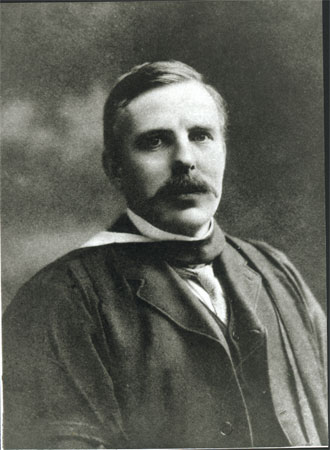
Ernest Rutherford (1871-1937)
Ernest Rutherford was born in August 1871 in Nelson, New Zealand. He was from 1898 the main pioneer with Marie Curie in the exploration of the atom. He is most famous for his discovery in 1911 of the atomic nucleus. He made many other discoveries which had earned him the Nobel Prize in 1908. He identified in particular the nature of alpha and beta rays and formulated the law of radioactive decay.
© ACJC
In October 1895, landed in England a 24 years-old young New Zealander. His name was Ernest Rutherford and he travel halfway around the world to enter a prestigious laboratory, the Cavendish Laboratory at Cambridge.
A month after his arrival, the announcement of the discovery of X rays by Roentgen shook the scientific world and public opinion. JJ Thomson, who welcomed him, is just about to find the electron and to become famous. In 1897, Thomson guided his young assistant on the Becquerel rays that they just started to hear about.
By January 1898, after completing his thesis, he published a study on the radiation of uranium, where he wrote : “These experiments show that the radiation of uranium is complex and involves two distinct types of radiation: one that is easily absorbed and will be called for convenience the alpha radiation, and the other, a more penetrating one, which is called beta”.
Appointed young professor at McGill University in Montreal, he met a young talented chemist in Canada, Frederick Soddy. With Soddy, he identifies radioactive emanation of radium as radon and he demonstrates that nature changes atoms when decaying.
That is still Rutherford who expresses the notion of the period and establishes a connection between alpha particles and helium. During his speech in Stockholm for the Nobel Prize in 1908, he even causes a stir by proving that these helium atoms are doubly charged.
Upon returning from Sweden, he started an experiment, known as his principal claim to fame. With extraordinary insight and flair, he interprets the results of his students Geiger and Marsden on “the diffusion of alpha particles” and shows the existence of a nucleus in the core of atoms in 1911.
Rutherford’s discoveries between 1898 and 1919 deserve more Nobel Prizes and would be sufficient to many busy lives. He had an extraordinarily pragmatic and practical mind; he was open to any new developments unforeseen, but accepted a result or an assumption only if it was based on rigorous experimentation. He was immediately able to see the consequences even far away in time of a newly discovered property.
Other articles on the subject « Discoveries »
Marie Curie
Marie Sklodowska-Curie had an exceptional destiny. Born in Poland, she came to graduate school in[...]
Three radiations
Understanding the nature of alpha, beta and gamma rays In the years following the discovery of ra[...]
Discovery of the Nucleus
A new vision of the atom In 1911, Rutherford, Marsden and Geiger discovered the dense atomic nucl[...]
Rutherford’s experiment
The experiment which proved the existence of a nucleus in the atom In 1908, Ernest Rutherford rec[...]
The neutron : Chadwick
A close competition between great physicists … James Chadwick, who discovered the neutron i[...]
Radium and Medicine
A short history: first steps in nuclear medicine … Everyone knows that the discovery of rad[...]
1934 : Artificial Radioactivity
The production at will of radioactive isotopes In the first days of 1934, Frederic and Irene Joli[...]
The Neutrino Hypothesis
The remarkable story of the neutrino The study of radioactive disintegrations had established tha[...]
Fission discovery
A nuclear phenomenon that escaped the hands of physicists In the years spanning 1934 to 1938, Enr[...]
Enrico Fermi
A genial experimenter and theoretician Enrico Fermi (Rome, September 29, 1901 – Chicago, No[...]